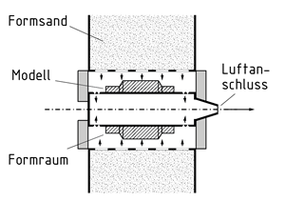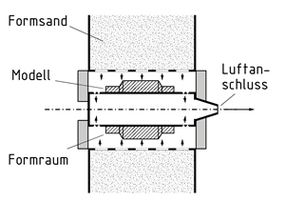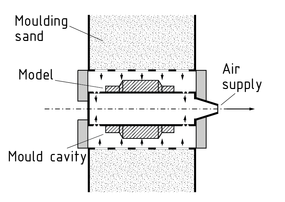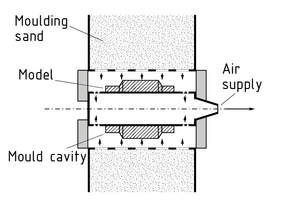
Choose one
or multiple languages
0,1,1
- German
- English
- Chinese
- Spanish
Suction moulding

Suction moulding (Casting process) involves the use of a disposable (expendable or single-use) mould made of synthetic green sand and a pattern made of wood, plastic or metal.
Air is extracted to create a vacuum in the mould cavity into which the moulding sand is fed. Acceleration causes the sand to adhere closely to the model. The moulding sand can be re-pressed from the model side. Suction moulding ensures the mould is compacted tightly around the model. It prevents shadow effects on flat surfaces. The moulding compound is poured into the hardened mould later.
The advantages of this process lie in the high dimensional stability of the casting due to low tolerances, excellent surface quality and low re-finishing workload. Iron and Aluminium materials are mainly cast in this process. This procedure is applied to the small, medium, and large-Scale production of small to medium-sized castings.
Saugformen

Beim Saugformen (Gießverfahren) werden eine einmal verwendbare (verlorene) Form aus synthetischem Nassgusssand und ein Modell aus Holz, Kunststoff oder Metall verwendet.
Durch Luftentzug entsteht ein Vakuum im Formraum, in den der Formsand einströmt. Durch die Beschleunigung legt sich der Sand eng an das Modell an. Der Formsand kann von der Modellseite her nachgepresst werden. Beim Saugformen entsteht eine optimale Verdichtung der Form um das Modell. Eine Schattenwirkung auf geraden Flächen wird vermieden. In die verfestigte Form wird später die Gussmasse eingegossen.
Die Vorteile des Verfahrens sind eine hohe Maßhaltigkeit des Gussstücks aufgrund geringer Toleranzen, eine hohe Oberflächenqualität und wenig Aufwand bei der Nachbearbeitung. Gegossen werden vor allem Eisen- und Aluminiumwerkstoffe. Angewendet wird das Verfahren in der Klein-, Mittel- und Großserienfertigung von kleinen bis mittelschweren Gussstücken.
吸压成型

吸压成型(铸造工艺)中使用由合成湿砂制成的一次性(消耗型或单次使用)的模具以及木材、塑料或金属制成的模型。
从型腔中引出气体以形成真空,然后填入型砂。加速度使砂粒紧贴模型。型砂可以从模型侧再加压。抽吸模制,吸压成型确保模具紧紧压实在模型周围。可以防止平面上的阴影效果。之后将铸模化合物倒入硬化的模具中。
这种工艺的优点在于铸件的尺寸稳定性高(由于公差低),表面质量优异和再次精加工的工作量小。这一过程中主要使用铁和铝材料进行铸造。此工艺应用于小型或中型尺寸铸件的小规模、中规模和大规模生产中。
吸压成型制造铸件
Moldeo por succión

El moldeo por succión (proceso de fundición) involucra el uso de un molde desechable (reemplazable o de uso único) hecho de arena verde sintética y un patrón hecho de madera, plástico o metal.
Se extrae aire para crear un vacío en la cavidad del molde en la cual se alimenta la arena de moldeado. La aceleración hace que la arena se adhiera estrechamente al modelo. La arena de moldeado puede volverse a prensar desde el lado del modelo. El moldeado por succión asegura que el molde sea compactado firmemente alrededor del modelo. Previene los efectos de sombra en superficies planas. El compuesto de moldeado luego se vierte en el molde endurecido.
Las ventajas de este proceso están en la alta estabilidad dimensional de la fundición debido a las bajas tolerancias, la excelente calidad de la superficie y la baja carga de trabajo para renovación de acabado. Se funden principalmente hierro y aluminio en este proceso. Este procedimiento es aplicado a la producción de baja, media y gran escala de fundiciones de pequeño y mediano tamaño.
Fabricación de un molde de succión para fundición
